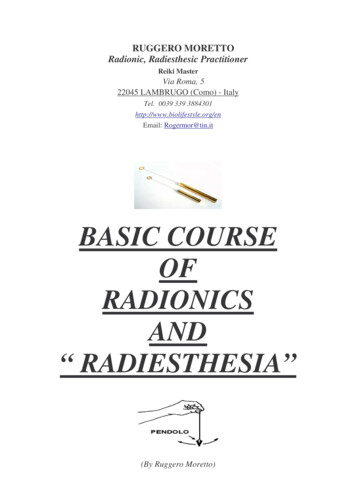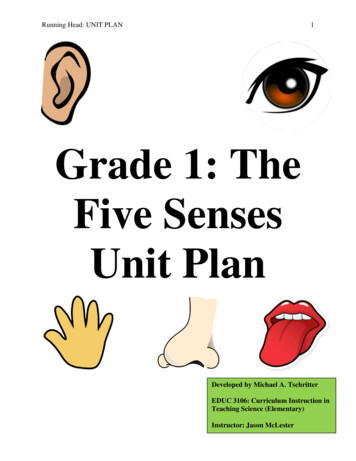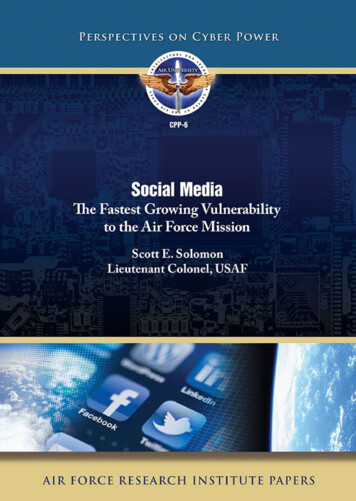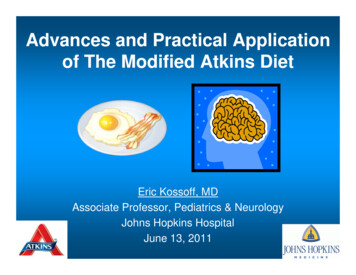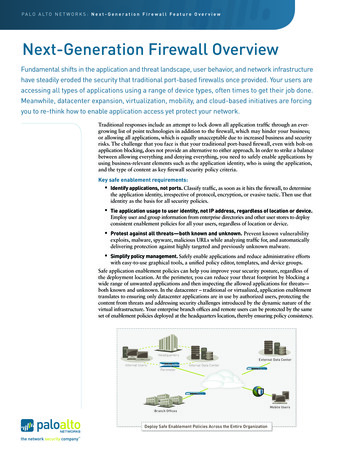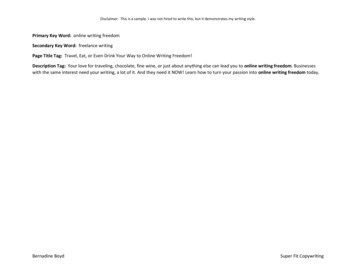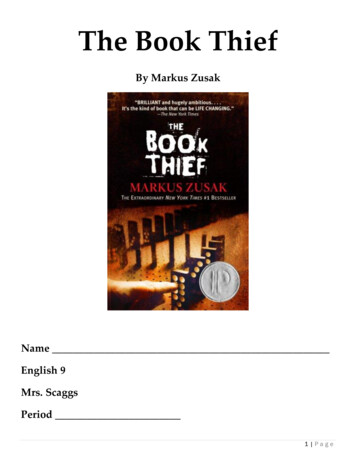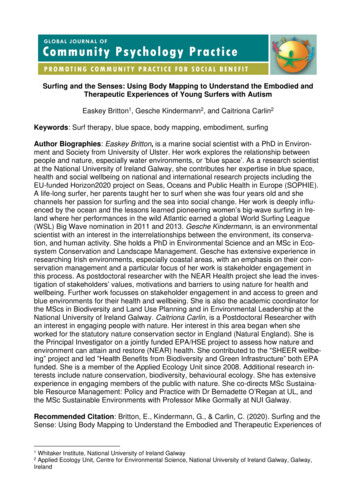
Transcription
Surfing and the Senses: Using Body Mapping to Understand the Embodied andTherapeutic Experiences of Young Surfers with AutismEaskey Britton1, Gesche Kindermann2, and Caitriona Carlin2Keywords: Surf therapy, blue space, body mapping, embodiment, surfingAuthor Biographies: Easkey Britton, is a marine social scientist with a PhD in Environment and Society from University of Ulster. Her work explores the relationship betweenpeople and nature, especially water environments, or ‘blue space’. As a research scientistat the National University of Ireland Galway, she contributes her expertise in blue space,health and social wellbeing on national and international research projects including theEU-funded Horizon2020 project on Seas, Oceans and Public Health in Europe (SOPHIE).A life-long surfer, her parents taught her to surf when she was four years old and shechannels her passion for surfing and the sea into social change. Her work is deeply influenced by the ocean and the lessons learned pioneering women’s big-wave surfing in Ireland where her performances in the wild Atlantic earned a global World Surfing League(WSL) Big Wave nomination in 2011 and 2013. Gesche Kindermann, is an environmentalscientist with an interest in the interrelationships between the environment, its conservation, and human activity. She holds a PhD in Environmental Science and an MSc in Ecosystem Conservation and Landscape Management. Gesche has extensive experience inresearching Irish environments, especially coastal areas, with an emphasis on their conservation management and a particular focus of her work is stakeholder engagement inthis process. As postdoctoral researcher with the NEAR Health project she lead the investigation of stakeholders’ values, motivations and barriers to using nature for health andwellbeing. Further work focusses on stakeholder engagement in and access to green andblue environments for their health and wellbeing. She is also the academic coordinator forthe MScs in Biodiversity and Land Use Planning and in Environmental Leadership at theNational University of Ireland Galway. Caitriona Carlin, is a Postdoctoral Researcher withan interest in engaging people with nature. Her interest in this area began when sheworked for the statutory nature conservation sector in England (Natural England). She isthe Principal Investigator on a jointly funded EPA/HSE project to assess how nature andenvironment can attain and restore (NEAR) health. She contributed to the “SHEER wellbeing” project and led “Health Benefits from Biodiversity and Green Infrastructure” both EPAfunded. She is a member of the Applied Ecology Unit since 2008. Additional research interests include nature conservation, biodiversity, behavioural ecology. She has extensiveexperience in engaging members of the public with nature. She co-directs MSc Sustainable Resource Management: Policy and Practice with Dr Bernadette O’Regan at UL, andthe MSc Sustainable Environments with Professor Mike Gormally at NUI Galway.Recommended Citation: Britton, E., Kindermann, G., & Carlin, C. (2020). Surfing and theSense: Using Body Mapping to Understand the Embodied and Therapeutic Experiences of1Whitaker Institute, National University of Ireland GalwayApplied Ecology Unit, Centre for Environmental Science, National University of Ireland Galway, Galway,Ireland2
Global Journal of Community Psychology PracticeVolume 11, Issue 2April 2020Young Surfers with Autism. Global Journal of Community Psychology Practice, 11(2), 1 –17. Retrieved Day/Month/Year, from (http://www.gjcpp.org/).Global Journal of Community Psychology Practice, http://www.gjcpp.org/Page 2
Global Journal of Community Psychology PracticeVolume 11, Issue 2April 2020Surfing and the Senses: Using Body Mapping to Understand the Embodied andTherapeutic Experiences of Young Surfers with AutismAbstractThere is a growing body of evidence for the benefits of the use of water-based activities andenvironments as an alternative or complimentary therapeutic intervention to mainstream,medicalised approaches. Surfing is one such activity with the health benefits of surf therapylinked to the fluid and dynamic nature of surfing and the sea, while learning to surf in agroup context can help enhance a sense of belonging and identity through shared experiences in the surf. This paper introduces the ways in which embodied and creative work innature can empower young people with mental health difficulties, in particular Autism. Thestudy explores embodied experiences and the use of a creative, participatory approach toevaluating a surf therapy intervention. As such, we investigate the usability of a novel participatory evaluation method, body mapping, to evaluate the feelings and emotional wellbeing of young participants in a surf therapy programme. Findings show how body mappingcan be used to help create a richer picture of the potential health and wellbeing outcomesfrom engaging with the sea and highlights surfing as psychosomatic experience. The paperhighlights the potential of in-situ embodiment practices and creative methodologies likebody mapping to support therapeutic processes, in particular those related to the imagination and emotional body, in a playful and engaging way.Given the global rise of medicalised interventions, especially among young people and theassociated high rates of prescription drug-useto treat anxiety and mood-related disorders,across all ages (Pratt et al., 2017; Sarginson etal., 2017), there has been a search for alternative solutions such as surfing and other waterbased activities as therapy (Britton et al.,2018). There is a growing body of evidence forthe benefits of ‘blue care’, the use of waterbased activities and environments (i.e. ’bluespace’) as an alternative or complimentarytherapeutic intervention to mainstream, medicalised approaches (Britton et al., 2018). Scholarship about surfing is increasing, in particular,understanding surfing as a therapeutic intervention (Marshall et al., 2019; Britton, 2019;2018; Wheaton, et al., 2017; Evers, 2015). Surfing is increasingly being advocated and implemented as a therapy for a range of physical andmental health issues, such as the NationalHealth Service (NHS) pilot programme (NHS,2014) in Dorset in the UK, a study identifyingpositive emotional impacts after 30 minutes ofsurfing (Pittsinger, 2010), the establishment ofthe International Surf Therapy Organisation,with a specific focus on building evidencebased research, and the popularity of surfingglobally as a ‘blue care’ activity (Britton et al.,2018).Although the mechanisms underpinning howsurf therapy contributes to wellbeing are notyet fully understood, the literature does suggest that learning to surf in a group context canhelp enhance a sense of belonging and identitythrough shared experiences in the surf (Hignett et al., 2017; Godfrey et al., 2015). In addition and central to any discussion of health andwellbeing, is the importance of immersion inproducing a sense of ‘respite’ from everydayand acquired anxieties and disabilities (Marshall et al., 2019; Wheaton, et al., 2017). Marshall et al. (2019) document this specificallywith young people dealing with mental healthchallenges or social isolation, who are engagedin surf therapy programmes. In addition,Wheaton et al’s (2017) review, identifiedstrongly positive developmental andhealth/wellbeing aspects of surfing programmes that are associated with the capacitybuilding potential of lifestyle sports like surfingand that can challenge more instrumental andstructured sports programmes. Yet, they andothers note that such surfing sites and experiences are also contested (Lazarow & Olive,2017). For example, a separate UK study ofGlobal Journal of Community Psychology Practice, http://www.gjcpp.org/Page 3
Global Journal of Community Psychology PracticeVolume 11, Issue 2youths with social behavioural problems notedthe social norms that can persist around watersports and surfing with youth from lower income backgrounds feeling socially and culturally excluded (Hignett et al., 2017). Althoughlimited, studies are emerging that go beyondthe action of surfing and point to the particularnature or quality of our interactions with waterand waves (Britton & Foley, in press; lisahunter, 2018). Emerging research on blue caresuggests that there is a relationship betweenthe environment in which an activity occursand improvements to wellbeing (Bell et al.,2018). Specific qualities of the natural environment that are particularly life-enhancing wereidentified in some studies, such as the feelingof weightlessness in salt-water and the connective properties of water environments, however this aspect is under-investigated (Brittonet al., 2018).Authors have also recognised the challenge ofmeasuring health and wellbeing outcomes inthese complex and dynamic outdoor, wet andfluid environments. For example, Britton et al.(2018) noted that wellbeing measures are often highly individualised and fail to account forthe socio-ecological factors of disadvantageand social inequality or indigenous models ofwellbeing (Mansfield et al., 2018; Ritchie et al.,2015). Traditional pre-post survey methodsthat rely on verbal or written communicationskills can also pose a challenge in wet environments and for diverse population groups whomay have a wide range of differing needs andabilities (Britton & Foley, in press). Increasingly, there are examples of creative approaches to ‘measuring’ wellbeing for groupswith diverse needs, for example, the ‘Measuring Wellbeing Creatively’ project, which workswith people who have communication difficulties because of a brain injury or stroke. It explores how different colours and sensationscan help them express feelings and emotions,which may help to measure their wellbeing.Body mapping is a creative, in-situ methodwith origins in art and dance therapy and hasbeen used as a participatory research evaluation process to examining embodied experience in physical space (Borovica, 2019; de Jäger et al., 2016; Fraleigh 2015). It is consideredparticularly effective when working with children and adolescents and can also be used as atherapeutic intervention (Kalucy et al., 2018;April 2020de Jager et al., 2016). Reported outcomes include shifts in participants sense of identityand self-awareness, improving confidence, interpersonal and communication skills for thosewith low self-esteem (Fullagar, 2019). Morebroadly, in‐situ methodologies are increasinglypopular within research into diverse geographies of health and wellbeing (Foley et al.,2019; lisahunter 2018; Evers, 2015). However,despite the moving, mutli-sensory nature ofocean and coastal environments, the use ofmore embodied practices and participatoryevaluation methods of therapeutic blue spaceinterventions is limited (Bell et al., 2018; Britton et al., 2018). An exception is a study by Berger and Tiry (2012), which draws upon creative methods including drama therapy to engage people coping with psychiatric disabilitiesin a therapeutic process at the beach.In this paper, we explore how young surfersengage with and utilise the sea and surf ashealth-enabling through the use of an in-situparticipatory evaluation method, body mapping. The paper is informed by empirical andparticipatory fieldwork in Ireland over thecourse of two summers ( 12 months) with anon-profit organisation called Liquid Therapy(LT) and one of their surf programmes calledthe Liquid Boardriders Club for youth with Autism Spectrum Disorder Level 1-1 and variousother mental health issues, who wish to develop their surfing skills. We present empiricaland sensory accounts drawn from direct experiences, along with critical reflections on theobserved experiences and experiments withbody mapping. The primary focus of the studyis how the novel use of an in-situ methodology,body mapping, can offer a rich understandingof the complex experiences of health, emotional wellbeing and active embodimentthrough surfing. This approach works with thebody, the senses and more elusive experiences,both literal and metaphorical. We investigatebody mapping as an evaluation approachaimed at exploring how experiences of and immersion in the beach space, sea and surf influence, shape and produce specific dimensions ofwellbeing. We tease out links with the immersive and human/non-human dynamics of thebody, sea and surfing and how best to capturethe articulation of those experiences. In choosing to use such a methodology, we argue thatthis is an approach that can help uncover differential accounts around how participants feelGlobal Journal of Community Psychology Practice, http://www.gjcpp.org/Page 4
Global Journal of Community Psychology PracticeVolume 11, Issue 2in place or building up to and winding downfrom a surf and how the acts of immersion inform and shape their health and wellbeing.These accounts move beyond the mind-bodyand self-nature dualisms and reveal a relational understanding of surfing. We draw onMerrel’s (2003) term bodymind to capture therelational entanglement of body, mind and nature. Fullagar et al. (2019, p.13) define“bodymind practices to be sites of dynamic intra-actions constituted through bodies-environments, bio-chemical flows, affective states andrelational power.”Research MethodologyThis study was approved by the NUI GalwayResearch Ethics Committee with informed consent received from both parents and participants. It was emphasised repeatedly that participating in the study was entirely optional,choosing not to it would in no way impact theability to participate fully in the surf lesson,they could opt-out at any time, and that itwould not take away from their time in the water. We draw on a key competency for community psychology (CP) practice by adopting aparticipatory community research approach,working in partnership with community members (e.g. surf therapy coordinators, surf instructors, volunteers, parents and participants)“to plan and conduct research that meet highstandards of scientific evidence that are contextually appropriate, and to communicate thefindings of that research in ways that promotecommunity capacity to pursue communitygoals.” (SCRA, 2012, p.13). In this paper wepresent findings from a preliminary, qualitativestudy appropriate to the context and purposesof the surf community and including morethan-human elements such as the beach, tides,waves, wind and weather (Abram, 2012). Inthis section we first outline the surfing intervention’s therapeutic process followed by adiscussion of the methods.Activity and SettingLiquid Therapy is based in county Donegal, arural region in the north-west of Ireland, andutilises the sea and surfing to tackle mentalhealth issues and surrounding stigma foryoung people by providing a range of tailoredsurf therapy programmes from one day surfingsessions to eight weeks for young people withApril 2020disabilities. Their programmes are designedwith a focus on mind-body, self-other, self-nature connections in a playful way (Fullagar,2008), rather than a focus on ‘physical activityfor (mental) health,’ which can dominate behaviour change and health promotion interventions. This study included participants fromthe Liquid Boardriders Club, an eight week surfprogramme with two hour surf lessons everyweek from July to August 2017 and 2018. Although instruction was given on the technicalaspects of how to catch a wave, stand up on thesurfboard and ride waves, the pedagogic ethoswas more concerned with the creation of anenabling and playful environment, meetingeach child at their individual level, made possible with the ratio of one-to-one instruction.The aim of LT is to create a positive, enablingenvironment for participants through surfing.Each surf session took place on Rossnowlaghbeach, considered one of the best and safestbeaches to learn to surf on the west coast ofIreland due its gently sloping profile, rollingwaves and lack of currents or hidden rips.ParticipantsA total of twelve surfers, seven girls and fiveboys aged 8 to 17, with Autism Spectrum Disorder Level 1-1 (ASD L1-1) and a mix of otherpsychological and anxiety disorders and learning issues commonly associated with ASD L1-1participated in the study. The surf programmedid not assess participants based on their diagnosis and no formal medical diagnosis was required to participate, welcoming participantswith a mix of various mental and physical disabilities. This particular programme, the LiquidBoardriders Club, was established in order tofacilitate an environment where participantscould assert greater independence, progresstheir surfing skills through peer learning andwhere the emphasis was not on surfing as atherapy or treatment. In some cases the children were not aware they had a formal diagnosis and in other cases, preferred not to beviewed as somebody with a mental health disability. Participants were occasionally referredor heard about LT via various support groupsand networks and / or word of mouth. In addition to the participants, their parents (n 11)and three volunteer instructors, including theprogramme organiser, were included in thestudy in semi-structured interviews.Global Journal of Community Psychology Practice, http://www.gjcpp.org/Page 5
Global Journal of Community Psychology PracticeVolume 11, Issue 2Body MappingIn response to the challenges of using traditional research methods in blue care settings,we wished to trial in-situ methods that relyless on verbal or written responses and weremore multi-sensory and embodied. Body mapping is a qualitative, participatory researchmethod that engages the senses and draws onsimilar methods used in dance therapy as wellas mindfulness-based practice. According toFullagar (2019, p.9) it, “incorporates art (drawing), reflection and narrative that provides themeans of creatively exploring the embodied interrelationship of personal and social worlds”,with a focus on the natural world in this study.Body mapping was used as an experimentalmethod with the study participants in the surftherapy programme as a different way of understanding complex experiences of physicalhealth and emotional wellbeing. We wanted toevaluate the usability of body mapping in a surftherapy setting to understand the sensory, embodied and emotional experiences of youngpeople. The evaluation was developed collaboratively as part of the surf programme, whilebeing conducted independently by the lead author of this paper. Informed by the somaticwork of Fullagar (2019) and Fraleigh (2015)amongst other movement practitioners, the integration of the body mapping researchmethod into LT surf sessions created a safe andenabling space where participants creativelyexplored, sensed and communicated their emotional and physical feelings. Similar to Fullagar(2019), we describe this research design as an‘assemblage model’ that recognises the interrelationships between the surf programme andevaluation methods that are productive of different ways of knowing (Borovica, 2019; Atkinson & Scott, 2015).The body mapping process was carried out onthe beach once participants were in their wetsuits and before their surf instruction began. Ittook 15-20 minutes and was facilitated by thelead author and carried out at intervals duringthe weekly surf sessions in week 2 and 4 of theeight week programme during July - August2017 and a follow-up one year later during thenext season’s programme in August 2018.April 2020Three different approaches to body mappingwere experimented with throughout the programme; i) using the sand and items found onthe beach as a canvas to create individual bodymaps before surfing, ii) using sheets of paperand coloured pencils and crayons to create individual body maps before surfing, and iii) using the sand to co-create a single, large collective body-map to represent the entire groupbefore and after surfing. Eight of the participants from the previous year participated inthis third exercise. This was also the only exercise to carry out body mapping before and after. On each occasion, participants drew theirbody outlines on the sand (except when the paper maps were used with generic print-outs ofbody outlines). To support a greater bodymindconnection, participants were invited to ‘scan’their body from head to toe, engaging as manysenses as possible and noticing any sensationsas they moved through their body, physical oremotional. After that, they used found objectsor drew in the sand in whatever way they feltcaptured or symbolised physical and emotionalfeelings and sensations. The findings from eachexercise are presented and compared in the results section. Upon completion of the bodymaps, participants were invited to share theirinsights about their maps and to connect withthe maps others had created in a whole groupdiscussion facilitated by the researcher.Prompt questions were asked to encourageparticipants to ‘notice’ feelings, and participants were invited to respond to open questions about: How and where they might feel emotions and sensations in the body,How they found the experience of bodymapping (what they liked / disliked),Anything they noticed about themselves that surprised them or theydidn’t notice before.Comments shared by participants were writtenin the researcher’s field-notes immediately following the activity and body maps were photographed. The process, outcomes, opportunitiesand limitations of these creative, embodied approaches to understanding complex feelingsand emotional wellbeing in relation to surfingare discussed in the following sections.Global Journal of Community Psychology Practice, http://www.gjcpp.org/Page 6
Global Journal of Community Psychology PracticeVolume 11, Issue 2Semi Structured Interviews and ParticipatoryObservationAt the end of the programme (week 8) semistructured interviews were carried out with instructors, parents and participants. Interviewstypically lasted 10 to 20 minutes. Instructorswere asked questions relating to the sea andsurfing and what they thought were particularhealth enabling qualities of both the settingand the activity and any changes they noticedin participants. Parents were asked to sharetheir observations about how their children experienced the sea and the impact of surfing ontheir overall health and wellbeing and participants were asked how the sea and surfingmade them feel. Interviews were recorded andtranscribed and a word frequency analysis wascarried out under the categories of ‘how surfing/sea makes me/my child feel.’ The findingsare discussed in relation to the outcomes of thebody mapping exercises in the results section.In addition to interviews, the lead author attended four surf sessions in week 2, 4 and 8during the summer of 2017 and a follow-upsession at the start of the programme in thesummer of 2018. During these sessions the researcher moved between the sea and thebeach, alternating between being in the surf asan observant participant (Smith, 2019) and onthe shore where parents spent their time whiletheir children surfed. This form of participantobservation acknowledges the active engagement of the researcher and helped to build rapport and a temporal understanding of place(Britton & Foley, in press).April 2020outdoors and the seaside, for the majority,their only opportunity to experience surfingwas with LT.Body Mapping OutcomesBody mapping 1 (BM1), July 2017During BM1 participants formed a circle on thebeach and took it in turns to draw a large outline of their body on the sand. Lying down, participants were invited to take a few momentsto focus on their breathing, bringing theirawareness into their bodies, noticing how theirbodies felt on the in-breath and out-breath (seeFig. 1a). This helped to settle and relax thegroup although some children found it difficultto be still and others preferred to sit instead oflie down. After the ‘body scan’ visualisation,participants created their personal body mapsdrawing on the surface of the sand or usingitems found on the beach space such as pebbles, shells, feathers and plastic bottle caps tosymbolise different sensations and feelings.For one to two minutes each, participants tookit in turns to share their bodymaps with eachother while the facilitator moved between thegroups observing the interactions (Fig. 1b).Everyone returned to the large group circle toshare their responses to the prompt questions.FindingsThis section presents the ways in which theparticipatory methodology of body mappingcan be used to help understand the complexexperiences of health, emotional wellbeing andactive embodiment as a process of change. Thissection presents the empirical and sensory accounts drawn from direct experiences of theparticipants, along with the observations of instructors, parents and participants elicited during semi-structured interviews. The body mapping sessions are described first, followed byresponses from the interviews. Although survey data (published elsewhere, see NEARHealth, forthcoming) identified each participant as physically active with a preference forFigure 1. (a-c) Participants taking part in abody mapping exercise before surfing.Discussions were lively and highlighted astrong bodymind connection with both physical and emotional feelings expressed. ‘Nega‐tive’ sensations or feelings of discomfort wereidentified such as an ‘X’ drawn between theshoulders to symbolise muscle tightness, andGlobal Journal of Community Psychology Practice, http://www.gjcpp.org/Page 7
Global Journal of Community Psychology PracticeVolume 11, Issue 2zig-zags or ‘Xs’ on hands and feet to symbolisefeeling cold in that part of the body (Fig 1c).Physical sensations were also linked with positive and mixed emotional responses, for example, wavy lines drawn on the middle of thebody represented the feeling of ‘butterflies inthe belly’, which participants described as feeling both excited and a little nervous.Body mapping 2 (BM2), August 2017At week 4 of the programme, BM2 was carriedout using pre-printed body maps on A4 sheetsof paper (Fig. 2). The process was the same except this time instead of creating body maps onthe sand body maps were created by drawingon and colouring on the sheets of paper. Having material objects and colouring pencils andcrayons seemed to help focus the attention ofparticipants. Creating the maps allowed individuals to quietly reflect and become absorbedin the act of colouring.April 2020the surf, the cooler greens and blues symbolised her connection to the sea. The body map ofa male participant in Fig. 2b shows the use ofcolour to symbolise various physical sensations with the blue representing cold hands,feet and head, the red colour was for stiffnessor soreness in the shoulder, ankle and wristsand the yellow colour was a feeling of excitement running through the body. Another participant used symbols to illustrate emotion,such as the feeling of excitement as a bodilysensation in her belly illustrated by the butterfly in Fig. 2c. This was not linked to nervousness but rather anticipation of having fun inthe surf and how that made her feel happy, illustrated with a smiling face. One participantchose to use the words ‘happy’ and ‘weird’ todescribe how she felt and drew them whereshe felt these emotions in her body (Fig. 2d).Another filled his body map with a mass ofdark squiggles to convey a complex mix ofemotions that he wasn’t able to tease out or articulate. The red colour symbolised stiffness inhis arms because he had been surfing earlierthat week and his arms felt a little tired (Fig.2e). The body map in Fig. 2f shows the use ofblue for cold in hands and feet. The female participant explained that the yellow in the headrepresented a sense of calm and pink in thecentre of the body symbolised a feeling warmthboth physically and for her love of surfing.Body mapping 3 (BM3), August 2018Figure 2. (a-f) Examples of body maps fromBM2 using paper hand-outs and colouring pencils.When sharing with the group, participantswere able to show and ‘talk through’ their bodymap, enabling them to express more creativelya mix of complex feelings through the use ofvisuals and colour. For example, the body mapin Fig 2a shows a spectrum of colours used bythe participant to illustrate the mix of emotionsshe was feeling. She explained that the warmcolours (pinks, oranges and reds) symbolisedher love of surfing and excitement to get intoOne year later, BM3 was carried out with thesurf club and included a total of eight participants from the previous summer. On this occasion, body mapping was carried out before andafter surfing by co-creating one large collectivebody map on the sand. Each participant was invited to draw or add to the body map in thecentre what they had noticed about theirbodymind (Fig. 3a). After surfing, as the surfersleft the water at slightly different times and thetide was now higher leaving less sand for themapping exercise, each participant was invitedto take a moment to notice how they felt intheir body and if they experienced any changes.They described and drew these sensations on anew body map drawn on the sand, capturingthe collective expression of how participantsfelt after surfing (Fig 3b). Due to low light /poor image quality this body map was redrawnlater on paper. Although this process was lessGlobal Journal of Community Psychology Practice, http://www.gjcpp.org/Page 8
Global Journal of Community Psychology PracticeVolume 11, Issue 2nuanced it did provide a more rapid and accessible way to integrate body mapping as part ofthe lesson plan and to capture bodymind experiences immediately after surfing before participants got too cold. It also illustrates the collective energy and emotional state of the group asa whole.Figure 3. (a-b) Before (a) and after (b) collective body mapsThe body maps before and after surfing highlight the interrelationship between body-mindenvironment, with a mix of physical and emotional states captured. Similar to BM1 and BM2,before surfing partic
Surfing and the Senses: Using Body Mapping to Understand the Embodied and Therapeutic Experiences of Young Surfers with Autism Easkey Britton1, Gesche Kindermann2, and Caitriona Carlin2 Keywords: Surf therapy, blue space, body mapping, embodiment, surfing Author Biographies: Easkey Britton, i

